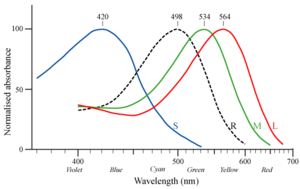George Wald
|
|
George Wald (November 18, 1906–April 12, 1997) was an American scientist who is best known for his work with pigments in the retina. He won a share of the 1967 Nobel Prize in Physiology or Medicine with Haldan Keffer Hartline and Ragnar Granit.
| Contents |
Research
As a postdoctoral researcher, Wald discovered that vitamin A was a component of the retina. His further experiments showed that when the pigment rhodopsin was exposed to light, it yielded the protein opsin and a compound containing vitamin A. This suggested that vitamin A was essential in retinal function.
In the 1950s, Wald and his colleagues used chemical methods to extract pigments from the retina. Then, using a spectrophotometer, they were able to measure the light absorbance of the pigments. Since the absorbance of light by retina pigments corresponds to the wavelengths that best activate photoreceptor cells, this experiment showed the wavelengths that the eye could best detect. However, since rod cells make up most of the retina, what Wald and his colleagues were specifically measuring was the absorbance of rhodopsin, the main photopigment in rods. Later, with a technique called microspectrophotometry, he was able to measure the absorbance directly from cells, rather than from a extract of the pigments. This allowed Wald to determine the absorbance of pigments in the cone cells (Goldstein, 2001).
Biography
Wald was born in New York City to Jewish immigrant parents. He received his Bachelor's of Science degree from New York University in 1927 and his PhD in zoology from Columbia University in 1932. After graduating, he received a travel grant from the US National Research Council. Wald used this grant to work in Germany with Otto Heinrich Warburg where he identified vitamin A in the retina. Wald then went on to work in Zurich, Switzerland with the discoverer of vitamin A, Paul Karrer. Wald then worked briefly with Otto Fritz Meyerhof in Heidelberg, Germany, but left Europe for the University of Chicago in 1933 when Adolf Hitler came to power and life in Europe became more dangerous for Jews. In 1934, Wald went to Harvard University where he became a instructor, then a professor. He was elected to the National Academy of Sciences in 1950.
Wald used his fame as a Nobel Prize laureate to speak out on many political and social issues. He was a vocal opponent of the Vietnam War and the nuclear arms race. Wald also became concerned about genital integrity issues and wrote in 1975 a still-unpublished essay for The New Yorker which he entitled "Circumcision". In 1980, Wald served as part of Ramsey Clark's delegation to Iran during the Iran hostage crisis.
Wald died in Cambridge, Massachusetts.
References
Goldstein, B. 2001. Sensation and Perception, 6th ed. London: Wadsworth.
External links
- Nobel Prize Biography (http://www.nobel.se/medicine/laureates/1967/wald-bio.html)
- Stop Infant Circumcision (http://www.stopinfantcircumcision.org/crick-wald.htm)de:George Wald

